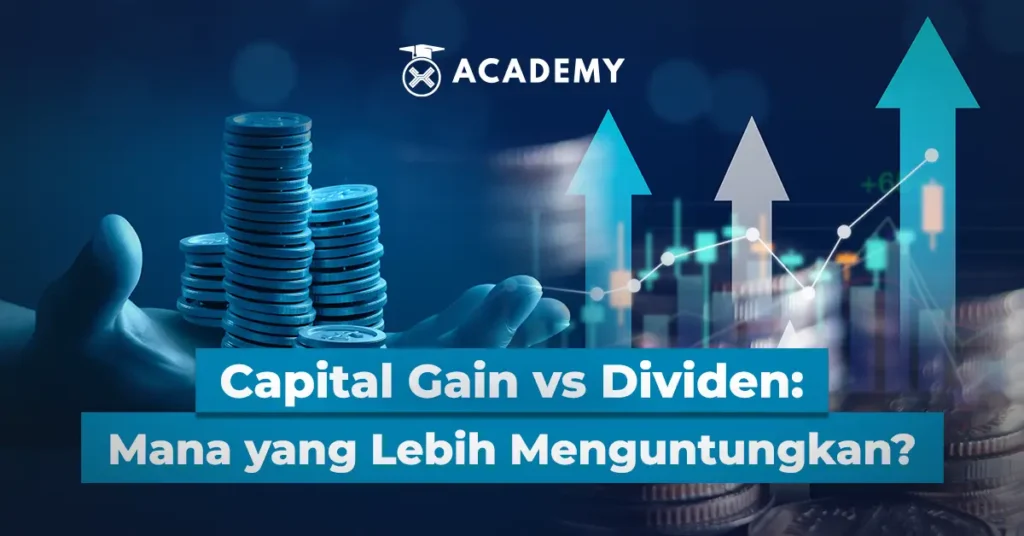Investment is an important step to realize various financial goals, from short-term needs to long-term plans.
One of the benefits that is often sought in investment is capital gain, which is the positive difference between the selling price of an asset and its purchase price.
Understanding capital gain is very important for investors because this knowledge helps in designing more effective investment strategies, maximizing profit potential, and managing risk better.
In addition, this understanding is also important in the context of tax planning because capital gain is often subject to taxation in various countries.
What is Capital Gain?

According to the Financial Services Authority (OJK), capital gain is a profit obtained from the difference between the purchase price and the selling price of an asset. Various types of assets can generate capital gains, such as stocks, bonds, property, businesses, and others.
Basically, capital gain is a profit obtained by investors when selling their investment assets at a higher price than the purchase price. In Indonesian, this term is known as capital gain.
The amount of profit from capital gain is calculated based on the difference between the selling price and the purchase price of an investment product. Conversely, if the selling price of the asset is lower than the purchase price, this condition is called capital loss.
This loss is also included in the category that can reach a large value, just like the potential capital gain which can be worth tens to hundreds of millions.
As an example of capital gain, if you buy 200 shares for IDR 10,000 per share and then sell them for IDR 12,000 per share, the capital gain obtained is IDR 2,000 per share.
Capital gains obtained, both by individuals and companies, are subject to Income Tax (PPh). The amount of this tax depends on the sale value of the shares, including transactions that generate profits or losses.In practice, tax payments on capital gains from buying and selling shares are usually deducted automatically through PPh when the sales transaction is carried out.
However, if you do not fulfill your tax obligations on short-term capital gains, the violation can be subject to sanctions in the form of fines.
Types of Capital Gains
The following are the types of capital gains that are important to know, especially for novice investors.
1. Short-Term Capital Gains
Short-term capital gains refer to profits generated from the sale of assets in less than 1 year. This type of profit is usually sought after by investors who are willing to take risks.
To achieve this profit, sharp analytical and predictive skills are required for market movements. Stocks are one type of investment that can provide short-term capital gains, although the risk is also quite high.
2. Long-Term Capital Gains
On the other hand, long-term capital gains refer to profits from the sale of assets that have been owned for more than 1 year. Compared to short-term profits, this type takes longer to realize.
Investment funds can usually only be disbursed after more than one year or according to the agreement that has been set. However, this type of profit is generally more stable and can provide more profitable results in the long term.
The Difference between Capital Gains and Dividends
Often considered the same, capital gains and dividends are basically two very different things. Here are some points of difference between the two that need to be understood.
1. Time of Profit
The first difference between dividends and capital gains lies in the time of receipt of the profit. Dividends are usually distributed routinely every year, with the amount determined at the General Meeting of Shareholders (GMS).
On the other hand, profits from capital gains can be obtained at any time, depending on the investor’s decision to sell their assets, which is not bound by company policy.
2. Nature of Income
The first difference between dividends and capital gains lies in the nature of receipt. Dividends are a form of passive income, where investors do not need to be actively involved in trading.
The profit is obtained by waiting for the distribution of profits made by the company in a certain period. On the other hand, capital gains are active because investors need to be involved in trading in the capital market.
To achieve this profit, investors must diligently conduct analysis and trading strategies because it will affect future profit results.
3. Amount of Income
In terms of the amount of income, the amount of dividends is determined at the General Meeting of Shareholders (GMS). The amount of dividends received depends on the number of lots of shares owned by the investor.
For example, if the dividend distributed is IDR 150 per share, and you have 250 lots or 25,000 shares, then the dividend that will be received is IDR 3,750,000.
Dividend calculations are different from capital gains, which are calculated based on the difference between the purchase price and the selling price of the shares. The greater the difference in price, the greater the capital gain obtained.
For example, if you buy shares for IDR 8,000,000 and sell them for IDR 10,000,000, then the capital gain you obtain is IDR 2,000,000.
How to Calculate Capital Gain
After discussing the definition of capital gain, the difference between dividends and capital gains, and the various types, next we will discuss the formula for calculating capital gain. Below is the formula used to calculate it.
Basic formula
Capital Gain = (Selling Price ? Purchase Price) × Total Assets
Calculation Example
To better understand the formula, consider the following example of calculating capital gain:
Suppose an investor buys shares for Rp5,000 per share and then sells them for Rp7,000 per share.
To calculate the capital gain obtained, the formula is:
Capital Gain = (Selling Price ? Purchase Price) × Number of Shares
In this example, we get:
Capital Gain = (Rp7,000 – Rp5,000) × Number of Shares
Capital Gain = Rp2,000 × Number of Shares
So, the capital gain obtained will depend on the number of shares sold.
When calculating capital gains, it is important to take into account the tax imposed on the capital gain. The tax is an additional charge imposed on the investor’s income and must be paid as a tax liability owed.
Strategy to Optimize Capital Gain

As explained earlier, capital gains will be taxed so it is very important to manage them carefully so as not to get caught in high tax obligations.
Here are some strategies that can be done to optimize capital gains that you need to know.
Understanding Asset Types
Each type of asset has different tax provisions. For example, profits from the sale of shares will be taxed at a different rate than profits from the sale of bonds.
Therefore, it is very important to understand the tax rules that apply to each type of asset you have.
Financial Goal Planning
It is important to set clear short-term and long-term financial goals related to capital gains. With careful planning, you can choose a more appropriate investment strategy and maximize potential profits.
If you plan to hold assets for the long term, one strategy to reduce the tax burden is to delay the sale of assets for more than 1 year.
Thus, you can take advantage of lower tax rates for long-term profits.
Analysis and Research
To optimize capital gains, it is also important to use technical and fundamental analysis. Technical analysis helps investors understand price movements based on historical data.
On the other hand, fundamental analysis focuses on economic conditions and company performance. With both approaches, investors can identify the right time to buy or sell assets to maximize potential profits.
Managing Risk
Portfolio diversification and use of investment tools to reduce the risk of capital loss.
Portfolio diversification is an important strategy in reducing the risk of capital loss. By spreading investments across various types of assets, whether stocks, bonds, or property, investors can protect themselves from unexpected market fluctuations.
In addition, the use of investment tools, such as stop loss or periodic portfolio rebalancing, can also help manage risk and maintain long-term profit stability.
Capital Gain Tax
In Indonesia, capital gain tax is imposed at 0.1% of the gross transaction value in the capital market, which is calculated based on the total share purchase and sale transactions, not just the profits obtained.
To prepare for tax payments, investors need to record all transactions carefully and carry out good tax planning.
Using the services of a tax consultant or digital platform can also help ensure accurate calculations, and delaying the sale of shares can be a strategy to take advantage of more favorable tax regulations.
Conclusion
Well, that was an interesting discussion about Capital Gain vs Dividends: Which is More Profitable? which you can read in full in the Crypto Academy article at INDODAX Academy.
In conclusion, understanding capital gains and their differences with dividends is very important for every investor. Capital gains are profits from the difference in the selling and buying prices of assets, while dividends come from the distribution of company profits.
Both have different characteristics in terms of income and taxes imposed. To maximize capital gains, it is important to implement the right investment strategy and plan taxes well.
It is also important for investors to continue learning and conducting in-depth research on the investments they choose. With sufficient knowledge, you can make wiser decisions and achieve your desired financial goals.
However, as a disclaimer, it is also important to always remember that investing carries risks and past results do not guarantee future results.
As additional information, INDODAX will soon present new investment options that include stocks from the United States (US).
With this addition, you can not only invest in crypto assets, but also manage more than 50 US stocks through one INDODAX account that can be accessed through the same application.
To start investing in US stocks, visit the “US Stocks” page on the INDODAX website, then click the “Explore Now” button to verify and get more information about the available stocks.
If you want to be one of the first investors, register your account on the waiting list by clicking “Verify Now” and following the verification steps listed.
FAQ
1. What is capital gain?
Capital gain is the profit obtained from the difference between the selling price and the purchase price of an asset, such as stocks or property.
2. What is the difference between capital gain and dividend?
Capital gain is obtained from the buying and selling of assets, while dividends are the distribution of company profits to shareholders.
3. How to calculate capital gain?
The formula is:
Capital Gain = (Selling Price ? Purchase Price) × Total Assets
4. Are capital gains taxed in Indonesia?
Yes, capital gains from shares on the stock exchange are subject to a final tax of 0.1% of the gross transaction value.
5. What are some strategies to maximize capital gains?
Some strategies include choosing the right type of assets, planning financial goals, and conducting market analysis.





 Polkadot 8.91%
Polkadot 8.91%
 BNB 0.54%
BNB 0.54%
 Solana 4.81%
Solana 4.81%
 Ethereum 2.37%
Ethereum 2.37%
 Cardano 1.35%
Cardano 1.35%
 Polygon Ecosystem Token 2.11%
Polygon Ecosystem Token 2.11%
 Tron 2.85%
Tron 2.85%
 Market
Market


